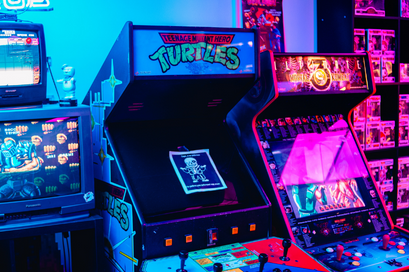Me, myself and my avatar - by Chris Pickard.
Chris Pickard, trainee counsellor, avid gamer, and threat intelligence analyst, explores the new and exciting ways that technology can aid counselling.
When I think back to my childhood, I see two versions of myself. On the surface, I was an average adolescent boy, going to school, squeezing spots and surfing the music channels in search of the latest Blink-182 anthem. But by night, I lived a different life; I was a magic-wielding warlock saving the world from destruction, a professional tennis player winning my first grand slam, or the leader of a group of brave adventurers crossing the universe in search of a new, habitable planet to call home.
These experiences took place in a virtual world, but they stand out as impactful events from my childhood that have stayed with me into adulthood (disclaimer, I am still an avid gamer.) Many of the feelings I experienced while gaming resurfaced during my counselling training, through reflective and explorative practices. I thought about the ethical dilemmas, such as choosing whether to save a well-loved character or let them die for the greater good, joining groups of friends playing a massively multiplayer online (MMO), or simply enjoying social interactions with people from all over the world. Gaming wasn’t just a hobby; it was a defining chapter of my early life. Negative perceptions and reporting have led to gaming being dismissed as a silly pastime, or something that will give children square eyes. (Remember that one? I can confirm my eyes are still perfectly eye shaped.) But in my experience, it’s so much more than that. Gamers acquire a breadth of skills and experience that contribute to childhood development. Whether it’s being faced with difficult decision-making, problem-solving or using creativity, my gaming experiences have undoubtedly shaped me. So why not explore that through counselling?
Gaming and Therapy: unlikely bedfellows?
There are numerous creative techniques for working with clients. Whether through play, art or sand tray, creative interventions are used to help clients express themselves in different ways, especially when ‘talking therapy’ isn’t enough. Although I enjoyed learning about traditional creative counselling methods, I found myself searching for ways that I could use technology, specifically computer games, therapeutically.
The thought that my love and knowledge could potentially be used to help others excites me. If the virtual spaces I inhabited as a child hold such prominence in my life today, they could surely be of similar importance to other young people having similar experiences, especially considering advancements in technology since I was a child playing on my low-resolution PlayStation 1. With ever-expanding virtual reality options available, games are more realistic and immersive.
Have you ever wanted to be a Jedi? Well, now you can experience what it’s like to hold a digital lightsabre and feel the vibrations of it in your hands; or fly around a city skyline with a jet pack; or walk across the surface of the moon. As experiences through technology become more realistic, so too do the strength of emotions, which are ripe for exploration between client and practitioner. When I think back to my most memorable experiences of gaming, it’s the games that allowed me to create my own character (or avatar) that stand out the most.
I spent hours making sure my avatar looked perfect, and that the stat points (a metric that represents a particular aspect of a character, such as strength or speed) I assigned matched who I wanted to be in the game world. Was my avatar strong enough for the challenges ahead? Would he be friendly to other characters or blow the heads off zombies? The way my avatar behaved in the game world would often mirror the way I would like to be in the real world.
The avatars I created were extensions of myself, my identity and the values I deemed important.
The Sims
Originally released in 2000, The Sims1 is not a game that takes you on a long, exciting journey with a twisting narrative, but one that invites players to create their own stories by simulating everyday life. When it comes to creating avatars, The Sims is a leader in its field. Players create an avatar (or Sim) from a multitude of options available. They choose how their avatar looks aesthetically, as well as applying specific personality traits. The aim of the game is to create a Sim and help them live their lives by meeting other Sims, starting relationships, climbing the career ladder and learning new skills and hobbies.
It has been claimed that the behaviour aspect was developed based on Maslow’s hierarchy of needs, with not just the character’s fundamental physical requirements needing to be maintained, but their desires relating to self-actualisation as well. It may sound trivial, but as a child I played this game for hours. The choice and freedom it provided was more than anything else I had experienced in a game before. I could either play in a sensible and realistic way – find a job that paid a decent salary, meet a life partner and start a family – or, I could go completely wild and live out my dream life by building a huge mansion with a swimming pool and tennis courts.
I would also create other Sims in the form of my friends and family, or even torture my bullies by trapping them in rooms with no doors and just a faulty cooker for company (yes, Sims can die). I believe The Sims has the potential to be used creatively with clients, especially when considering themes of identity and sense of self. Carl Rogers’ self-concept is based on a person’s thoughts and feelings about themself from a physical, personal and social perspective and how they feel about their The avatars I created were extensions of myself, my identity and the values I deemed important BACP Children, Young People & Families | September 2022 In practice 15 behaviour, skills, capabilities, traits and characteristics. With this in mind, could The Sims offer a creative platform to help clients explore their self-identity? They have multiple options when it comes to choosing their gender, body type, facial features and clothing styles. Perhaps more interestingly, clients playing the game would also have the option to choose personality traits to apply to their newly created digital self.
Exploring the choices clients make while creating their avatars has the potential to provide real insight into how they visualise different versions of self. It could help them explore their perceived self, what they like, don’t like, their strengths, their pitfalls and, ultimately, how they would like to be.
Killing Zombies
I have experienced how effective gaming can be while working as a volunteer befriender for a mental health charity. Befriending sessions usually take place over the phone, but with one particular client, I found our initial phone calls were not making productive use of the limited time we had. It was clear that the client felt uncomfortable speaking on the phone; I soon became concerned that we weren’t making much progress and felt I needed to adopt a more creative approach. It transpired that my client was also a passionate gamer, leading me to ask if he would like to play an online co-operative game, which enabled us to work together to navigate complex and challenging situations (as opposed to competing against each other).
We settled on Left 4 Dead 2, a zombie survival game, where players try to survive in a post-apocalyptic world ravaged by the undead. To me, this was the perfect tool: not too thought-provoking but requiring communication and teamwork while scavenging for supplies and taking on hordes of zombies. Initially, we played without any expectations. My intention was to remove the pressure and formalities associated with phone calls and join the client in a space that he was familiar and comfortable with. My aim was to simply play the game, build trust and have fun. After several weeks of blowing the heads off zombies, it felt as though the therapeutic relationship was getting stronger. Like the zombies bashing away at the defences in the game, I could feel the barriers between us beginning to break down. Over time, my client became more conversational and confident to discuss personal topics.
Our zombie-killing sessions continued for some time. We played while talking about whatever the client wanted to talk about, with our relationship building to the point where he no longer felt the need to play games during sessions. We reverted to the more traditional phone sessions and explored issues in greater depth. I believe this more creative approach in the initial stages helped our therapeutic relationship to develop in a more natural way. Chopping the limbs off zombies had laid the foundations for relational depth.
The Future
Away from traditional gaming, the rise of more affordable virtual reality has opened the door to exciting possibilities in relation to counselling and therapy. Being able to meet a client in a space where they feel comfortable is an important part of the therapeutic process; so why not extend that to the virtual world? Some companies are already using technology for exposure therapy, helping clients to overcome their fear of heights or social anxiety by simulating tall buildings or crowded places in virtual reality. Professor Tom Craig at King’s College London has been using avatars to create digital representations for people who suffer from distressing auditory hallucinations, allowing them to create a virtual manifestation of the hallucinatory voices they are troubled by.
The NHS recently released an app to help people overcome anxious social avoidance by applying cognitive behavioural therapy techniques within an immersive virtual reality setting, tasking clients with completing various objectives that would normally be beyond their comfort zones.7 I’m particularly interested in using technology to work with clients virtually. Technology such as haptic feedback, which enables us to touch and feel objects in a virtual world, eye and mouth tracking, to show real-time facial expressions, and the ability for clients to create any virtual space they want, provides the potential to make every counselling setting bespoke.
Meeting a client in a space that is created and controlled by them could be hugely beneficial for the development of the therapeutic relationship.8 I am still at the start of my counsellor career and looking forward to exploring all the ways I can combine my passion for gaming and technology with my counselling practice, whether that’s meeting clients in a virtual space they have designed themselves, battling hordes of zombies to break the ice, or helping someone create their own personalised version of their ideal self through a digital avatar. Technology means that the possibilities are limitless. And that excites me.
- Chris Pickard - Advanced Diploma in Integrative Counselling Student
‘This article first appeared in the September 2022 issue of BACP Children, Young People & Families, published by the British Association for Counselling and Psychotherapy. https://www.bacp.co.uk/bacp-journals/bacp-children-young-people-and-families-journal/BACP 2022©’. Please check the website for references.


